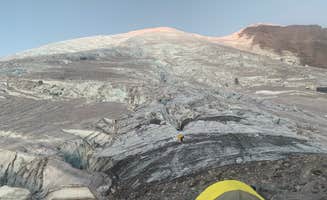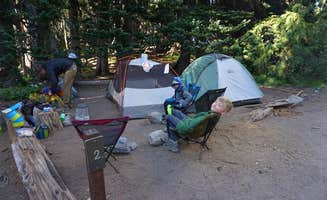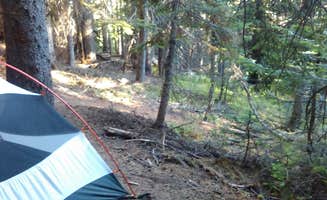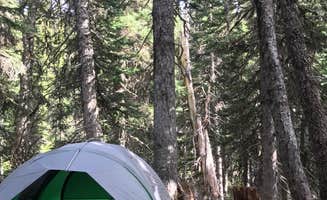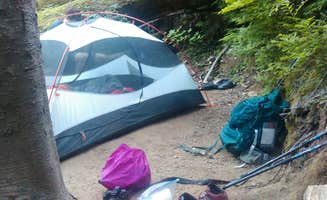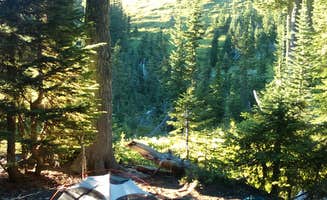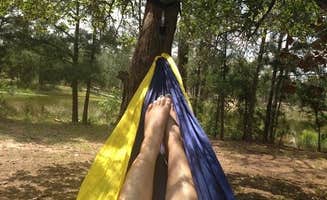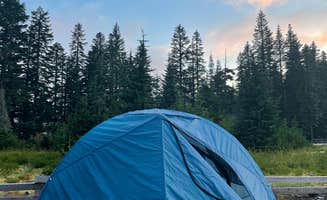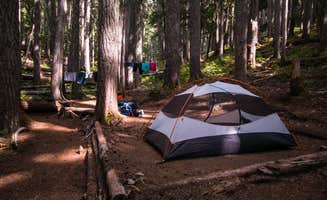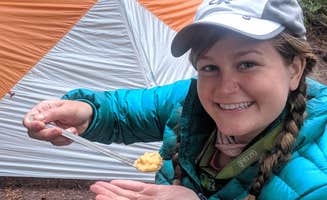Mount Rainier National Park offers diverse tent camping options at elevations ranging from 1,800 to 10,000 feet. The northeastern section provides easier access to primitive tent sites while the western regions typically require more hiking effort. Temperatures can vary dramatically between lower and higher elevations, with nighttime temperatures at higher-elevation sites frequently dropping below 40°F even during summer months.
What to do
Hike to waterfalls: Start from Mowich Lake Campground for multiple trail options. "We did the Tolmie Peak trail and the trailhead is straight off the campground which is super nice," reports one camper who appreciated the convenient access to hiking routes.
Stream fishing: Access the White River from nearby campsites for fishing opportunities. "Spots are close to the water and others in the trees. Great views and I felt very safe as a solo traveler," notes a visitor to the area, highlighting the variety of site locations.
Wildlife viewing: Look for marmots in subalpine meadows at higher elevations. At Summerland Backcountry Campsites, "Lots of marmots, including in the camping areas. Seemed more interested in munching on lupines than bothering us," writes a camper who enjoyed the animal presence without disturbance.
What campers like
Secluded forest sites: Eagles Roost Camp offers privacy despite proximity to other sites. "While you can be fairly close to fellow campers you still get a good sense of privacy. All of the sites have good level tent pads and enough room for at least 2 tents," explains a visitor who appreciated the campground layout.
White River sound barrier: The sound of running water masks road noise at dispersed sites. "We found a spot right next to the river. There were a few other people, but everyone was very quiet. You could see the lights and hear the cars driving on the main road, but they eventually stopped," noted a tent camper who valued the natural sound barrier.
River access: Many sites offer direct water access. At White River Dispersed Camping, "The second night, I managed to find a spot tucked super far in that had a small private beach. It was farther from the road so you couldn't see or hear anything," shares a camper who found an ideal secluded location.
What you should know
Permit requirements: Backcountry camping requires wilderness permits secured at ranger stations. For Ipsut Creek, a camper explains: "Be sure to check in with the rangers for a wilderness permit before heading into camp."
Fire restrictions: No campfires allowed at higher elevations. "Sadly you cannot build a fire here so it does get really cold at night time because there are glaciers in the park," warns a Mowich Lake visitor, emphasizing the need for warm gear.
Bear safety protocols: Most backcountry sites have communal bear storage options. At Granite Creek Camp, visitors should "follow the signs along the trail past the bear pole and you'll arrive at your very own forest bathroom," according to one camper who appreciated the facilities.
Road conditions: Many dispersed sites require travel on rough roads. "The road can be a bit thin, so I would be careful with extra large vehicles. It is also a bit of a challenging road, so low clearance vehicles wouldn't be treated well," cautions a White River camper.
Tips for camping with families
Choose walk-in sites: Shorter hikes are better for children. "It's a short hike from Mowich Lake, which has its own campground, but there are only a few spots here, which makes it quiet," mentions an Eagles Roost visitor, highlighting the balance of accessibility and solitude.
Pack for variable weather: Temperature swings can be extreme, even in summer. "Mount Rainier likes to create its own weather. Got trapped in a thunderstorm while there with torrential downpours," warns a Ipsut Creek Backcountry Campground visitor.
Arrive early: First-come sites fill quickly, especially weekends. "We got there at like 3pm on a Tuesday and got one of the last 2 spots, it definitely fills up fast even during the week," shares a tent camper about the competitive nature of site acquisition.
Tips from RVers
Limited options: Most tent camping near Mount Rainier requires hiking in. On NF-52, "If you don't mind sleeping five feet from a busy paved road, fine, but these sites are mostly glorified gravel shoulders on the side of the road with no views whatsoever," reports one disappointed visitor looking for vehicle access.
Consider dispersed camping: Forest Service roads offer alternatives to park camping. "Lots of campsites along the White River right outside of Rainier National Park. We arrived mid afternoon on a Friday and there were plenty of options to pick from but it did fill up by around 9pm," notes a camper who found success with this approach.


